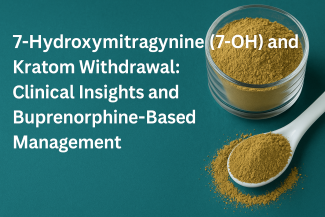7-Hydroxymitragynine (7-OH) and Kratom Withdrawal: Clinical Insights and Buprenorphine-Based Management

7-Hydroxymitragynine (7-OH) and Kratom Withdrawal: Clinical Insights and Buprenorphine-Based Management
By Benjamin Zohar, NCACIP
Moderator – ISSUP Network #447 (7-OH / Kratom Discussion)
Introduction
Kratom (Mitragyna speciosa) is a Southeast Asian plant whose primary alkaloids—mitragynine and 7-hydroxymitragynine (7-OH)—act on the same mu- and delta-opioid receptors affected by heroin, fentanyl, and prescription painkillers. While the natural leaf contains only trace levels of 7-OH, modern concentrated kratom extracts can reach opioid-like potency, producing tolerance, dependence, and withdrawal syndromes.
According to the National Institute on Drug Abuse (NIDA) and the U.S. Drug Enforcement Administration (DEA), kratom’s pharmacology resembles that of opioids, and long-term use can lead to addiction, withdrawal, and in rare cases, toxicity when mixed with other substances.
Essential Facts About Kratom, 7-OH, and Detox
- Kratom is not a harmless herbal supplement. Both mitragynine and 7-OH are opioid-receptor agonists. See NIDA and DEA Fact Sheet.
- 7-OH can be stronger than morphine. Concentrated or adulterated products cause more dependence. See EMCDDA Kratom Profile.
- Withdrawal can be as severe as opioids. Reported symptoms include body pain, tremors, vomiting, insomnia, anxiety, and dehydration. (UIC Drug Information Group)
- Unregulated gas-station kratom products can be adulterated. The FDA has seized kratom supplements containing undeclared opioids and benzodiazepines.
- No FDA-approved medical use. The FDA recommends placing 7-OH under the Controlled Substances Act due to its abuse potential.
- New York’s Suffolk County restricts sales to adults only. Local Law §423-46 – §423-47 prohibits kratom sales to anyone under 21.
- Medical detox is the safest option. Sudden withdrawal without supervision can trigger complications. Find licensed help at SAMHSA Treatment Locator.
- Buprenorphine (Suboxone® / Subutex®) can help. Case evidence supports buprenorphine-based tapers for kratom withdrawal (Arhin et al., 2023 – Cureus PMCID: PMC10386870).
- Recovery requires more than detox. MAT, behavioral therapy, and community support are key (NIDA Treatment Approaches).
- You are not alone—help is available. Contact SAMHSA.gov or 1-800-662-HELP. Family coordination resources: Intervention New York.
Clinical Evidence: Buprenorphine-Based Treatment
Recent case studies describe successful kratom detoxification using buprenorphine/naloxone (Suboxone®) and buprenorphine-only (Subutex®) tapers. A 2023 report in Cureus (PMCID PMC10386870) showed complete remission after a six-month taper. Similarly, the University of Illinois Chicago Drug Information Group found consistent results across multiple case reports.
Most programs combine Medication-Assisted Treatment (MAT) with counseling, relapse prevention, and ongoing recovery planning. Patients are encouraged to remain on MAT or taper gradually under clinical supervision.
References
- DEA – Kratom Drug Fact Sheet.
- FDA – Seizure of Adulterated Kratom Supplements (2021).
- Arhin M et al. (2023). Successful Management of Kratom Use Disorder With Buprenorphine and Naloxone. *Cureus.*
- UIC Drug Information Group (2023) FAQ on Buprenorphine for Kratom Withdrawal.
- National Institute on Drug Abuse (NIDA). Kratom Research Topic.
- European Monitoring Centre for Drugs and Drug Addiction (EMCDDA) – Kratom Drug Profile (2015).
- Suffolk County Local Law §423 – Sale of Kratom.